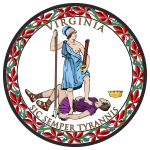Virginia House of Delegates

The Virginia House of Delegates is one of the two parts of the Virginia General Assembly, the other being the Senate of Virginia. It has 100 members elected for terms of two years; unlike most states, these elections take place during odd-numbered years. The House is presided over by the Speaker of the House, who is elected from among the House membership by the Delegates. The Speaker is usually a member of the majority party and, as Speaker, becomes the most powerful member of the House. The House shares legislative power with the Senate of Virginia, the upper house of the Virginia General Assembly. The House of Delegates is the modern-day successor to the Virginia House of Burgesses, which first met at Jamestown in 1619. The House is divided into Democratic and Republican caucuses. In addition to the Speaker, there is a majority leader, majority whip, majority caucus chair, minority leader, minority whip, minority caucus chair, and the chairs of the several committees of the House. Only Maryland, Virginia and West Virginia refer to their lower house as the House of Delegates.
Excerpt from the Wikipedia article Virginia House of Delegates (License: CC BY-SA 3.0, Authors, Images).Virginia House of Delegates
Bank Street, Richmond Shockoe Slip
Geographical coordinates (GPS) Address Phone number Website Nearby Places Show on map
Geographical coordinates (GPS)
| Latitude | Longitude |
|---|---|
| N 37.53865 ° | E -77.43331 ° |
Address
Virginia State Capitol
Bank Street 1000
23219 Richmond, Shockoe Slip
Virginia, United States
Open on Google Maps











